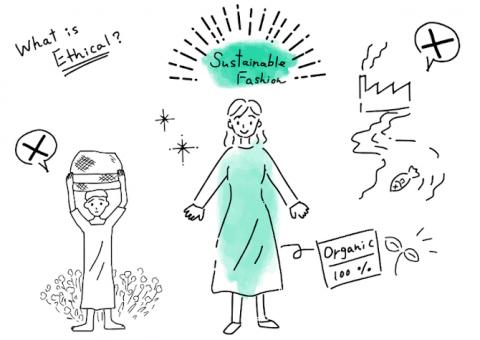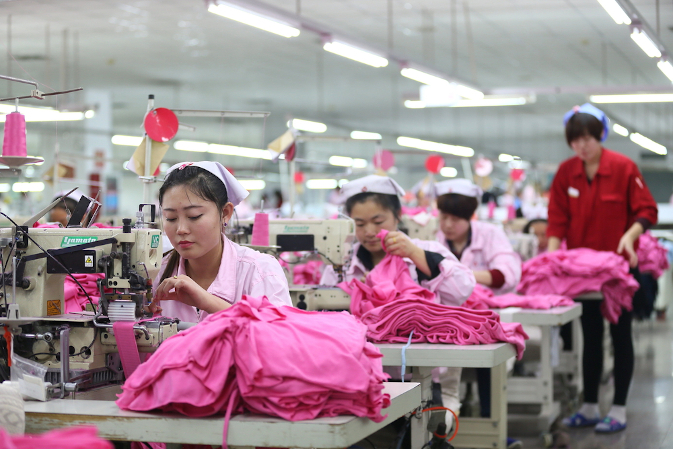Eco-Friendly and Ethical: The Rise of Sustainable Fashion

(Photo credit: Depositphotos.com)
In a world awash with fast fashion—a place where the only thing faster than the changing of styles is the depletion of our environment—it seems the fashion industry is finally catching up to what the Earth (and activists) have been telling it for years: Slow down. Enter sustainable fashion, the dashing hero in a cashmere, ethically made armor. But as we’ve come to realize in our age of misinformation and marketing ploys, not all heroes wear capes, especially not sustainably made ones.
Fashion has long had a questionable reputation. The $2.5 trillion industry (yes, trillion) has historically been tied to myriad environmental and social injustices—from child labor to water pollution, from deforestation to unspeakable amounts of waste. As per the Ellen MacArthur Foundation, the textile industry emits more greenhouse gas emissions than international shipping and flights combined. If this industry were a country, it would be a sixth largest polluter in the world, sitting right behind the globe’s major emitters --though this number is oftentimes difficult to calculate because the industry’s multilayered supply chain is very opaque. Alas, the winds of change may be here, whispering sweet promises of “sustainability.” On paper, this shift sounds like it could be nothing short of revolutionary. And yet, one must wonder: Is sustainable fashion genuine in its pursuits, or is it yet another iteration of the age-old capitalist ploy to paint products green and appeal to the environmentally-conscious consumer?

(Photo credit: Depositphotos.com)
After all, not all that glitters is gold, and not everything labeled “sustainable” is actually good for the Earth. There's a term for it: greenwashing. Greenwashing is when companies use misleading information to appear more environmentally friendly than they genuinely are. A great example is when some major brands boast about a single “sustainable” clothing line, while their primary lines continue business-as-usual, with all the environmental degradation and exploitation that comes with it. It’s akin to putting a bandage on a bullet wound and calling it fixed. And sure, even if they represent a small fraction of their total offerings, these efforts are indeed steps in the right direction. But the criticism arises when these sustainable lines are used primarily as a marketing tool to project an overall image of sustainability, potentially overshadowing the less sustainable practices still prevalent in the majority of their operations. Such instances can be seen as greenwashing if not balanced with genuine efforts to overhaul their primary lines and business models to be more sustainable and ethical.
But before we can appreciate the true essence of sustainable fashion, it’s worth diving deeper into the environmental impact of its nemesis: fast fashion. Understanding the depths of this problem might make the solution seem even more imperative. Each year, the fashion industry produces over 100 billion garments, with the majority stemming from the fast fashion sector. A staggering amount of these—nearly 75 percent—eventually end up in landfills. That’s not even mentioning the 2,700 liters of water it takes to make just one cotton shirt, equivalent to drinking water for a person for two and a half years. In countries like Bangladesh and India, toxic wastewater from textile factories is often dumped untreated into rivers, leading to unusable water sources and massive fish deaths. One doesn’t have to be a scientist to realize that this consumption rate is unsustainable. The Earth simply cannot keep up.
Beyond environmental concerns, the fast fashion industry has been repeatedly spotlighted for its questionable labor practices. Who can forget the tragic Rana Plaza collapse in 2013 in Bangladesh? Over 1,100 garment workers, mostly women, lost their lives, with many more injured, because of lax safety standards and the relentless push for cheaper production costs.
It's not all gloom and doom, though. There are brands that genuinely take sustainability to heart, but distinguishing them from the greenwashers requires a discerning eye.

(Photo credit: Depositphotos.com)
Eileen Fisher, for instance, is a brand that's taken its commitment to sustainability beyond just the catchy taglines. They have a line called "Renew" that's solely dedicated to upcycled clothing, giving garments that might have been discarded a second chance at life. They have also committed to organic materials and ethical labor practices. Patagonia has turned its entire ethos around environmental and social responsibility. They offer repair services for their clothes, ensuring longevity and reducing waste, not to mention their advocacy for environmental causes and transparent supply chains. If more brands adopted a fraction of Patagonia’s ethos, the fashion landscape would look markedly different. Interestingly, though, Patagonia does not use the term “sustainable” in any of their branding, likely because being less unsustainable is not quite the same thing as sustainable.
For every Eileen Fisher and Patagonia, though, there's a host of other brands hiding behind the veil of ambiguity. What would genuine sustainability in fashion look like? One aspect must come from our collective psyche. We, as consumers, just buy too much. Part of the blame for that can undoubtedly be placed on the industry’s marketing tactics. New seasons, limited-time collections, and the ever-present fear of “missing out” on the latest trend are all strategies to entice constant purchasing. But this endless cycle of buying and discarding has left many feeling hollow: a wardrobe full of clothes, yet “nothing to wear.” This, paradoxically, might be sustainable fashion's most substantial selling point—the idea of purchasing less, but better. Quality over quantity. A shift from mindless consumption to conscious choices.
True sustainable fashion moves from a linear model ("take, make, dispose") to a circular one. In a circular model, products are designed and created to last. Once they’ve served their purpose, they can be repaired, reused, or recycled, not just discarded. Some pioneering brands are now offering services like leasing clothes or taking back old items to repurpose. This shift doesn't just reduce waste, it could also revolutionize our relationship with our possessions. This is why true sustainability should go beyond just the clothes and be about the entire lifecycle. It considers the sourcing of raw materials, production processes, labor practices, distribution, and end-of-life management of products. It should be about ensuring that every step of the process is done with thought and care for both the planet and its inhabitants.

(Photo credit: Depositphotos.com)
Consumers, of course, face the daunting task of sifting through brands, trying to discern the genuinely sustainable from the frauds. It’s an exhausting endeavor, one that the industry doesn’t make any easier. Brands tout terms like “eco-friendly,” “green,” and “ethical,” without substantial backing or clear definitions. It's a murky pool of marketing jargon. Yet, hope isn't lost. Because it may seem formidable, but brand transparency and accountability can manifest in numerous ways, offering a clear view into every facet of the business and product lifecycle, while being answerable to stakeholders and continuing to strive for ethical and environmental progress.
There are third-party certifications and labels to look for, such as the Global Organic Textile Standard (GOTS) or the Fair Trade certification, which can lend credence to a brand's sustainable claims. Furthermore, websites like the Fashion Revolution's Fashion Transparency Index work to shed light on how brands are truly operating, helping consumers make informed choices. (Brands can also embrace these third-party audits and investigations into their supply chains, labor practices, and environmental practices, allowing these external organizations to evaluate their operations and then acting on recommendations to demonstrate genuine commitment.)
Brands can provide supply chain information, giving a breakdown of where and how each garment is made. This includes the sourcing of raw materials, the factories involved, and the transportation methods used. For instance, Everlane's "Radical Transparency" initiative provided a comprehensive view of the factories where their products are made, offering insights into costs, production processes, and even the factory workers' daily lives (though Everlane has been criticized by its own employees who called into the question the company’s real impact and shady sustainability marketing practices).

(Photo credit: Depositphotos.com)
Similar to annual reports, brands can release regular updates detailing their environmental impact, efforts towards sustainability, and goals for the future. The H&M Group, for example, publishes an annual sustainability report highlighting its progress in different areas and future intentions (though it’s worth noting that H&M is one of those that touts a single sustainable line, their “Conscious Collection,” which sounds nice but it also begs the question why their entire catalog is not “consciously” made). Brands can also engage in industrywide initiatives and collaborations to push for sustainability. Joining platforms like the Sustainable Apparel Coalition and actively participating in collaborative tools like the Higg Index can show that a brand is not only interested in individual progress but industrywide change (though these have also come under scrutiny after reports deemed the methodology insufficient and lacking necessary data). But if anything, as those parentheticals make clear, even all of this is easier said and marketed than implemented to make a real impact.
In an ideal world, all fashion would be sustainable. But we’re far from that utopia. The challenge, then, is for the fashion industry to step up its game: to offer genuine transparency and accountability. Until every brand can prove that they’re committed to real change, consumers must remain vigilant. They must question, probe, and demand evidence. Fashion is a beautiful way to express oneself, but it shouldn't come at the expense of our planet or the individuals who work tirelessly behind the scenes. Sustainable fashion can, and should, be the way forward. However, for it to be genuinely transformative, it requires both brands and consumers to be honest, informed, and relentlessly committed to change.
Sustainable fashion is more than just a buzzword—it's a movement and a necessary one at that. It challenges our consumption habits, pushes for industry reform, and emphasizes the interconnectivity of our actions. Every shirt bought, every brand supported, sends a ripple effect through a vast web of environmental and social contexts. The fashion industry has a long way to go, but with persistence, discernment, and genuine commitment, sustainable fashion can be more than just a fleeting trend. It can be the future.

(Photo credit: Depositphotos.com)
Author Bio:
Angelo Franco is Highbrow Magazine’s chief features writer.
For Highbrow Magazine
Image Sources:































































































































































































































































































































